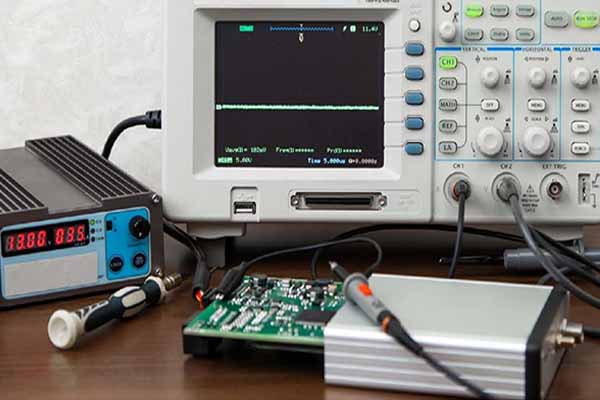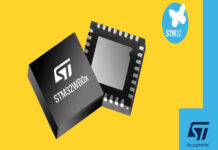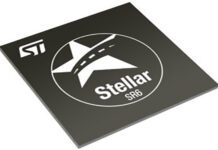In EMC measurements, the time and cost factors are becoming increasingly important. As a specialist for real-time measurements and full-range supplier in the field of measurement technology, Aaronia AG offers the technician a wide product portfolio of the most diverse antennas as well as accessories for the most diverse requirements.
The real-time spectrum analyzers of the SPECTRAN V6 X USB series are specially designed for near- and far-field measurements, for measuring and localizing sources of interference radiation or for monitoring EMC problems. The real-time bandwidth of up to 500MHz as well as the sweep speed of >3,000 GHz/s enables EMC measurements in real-time.
At EMV 2023, the world leader in USB real-time spectrum analysis recently set a new record. On three side-by-side Samsung Odyssey Ark monitors, each measuring 55 inches, they not only displayed the entire 6 GHz RF spectrum via a single PC, but also set a new world speed record at the same time with a sweep speed of over 3 THz/s. “We are always looking for better and faster measurement systems” elaborates Thorsten Chmielus, CEO of Aaronia AG. “Our USB real-time spectrum analyzers of the SPECTRAN V6 series are the result of continuous development work. The demands on modern equipment are becoming ever greater as the complexity of signals increases. The future of measurement technology lies in flexible, modular solutions for every application, such as we offer.”
The modular real-time spectrum monitoring software “RTSA-Suite PRO” including recording and playback functions is included with all SPECTRAN V6 USB real-time spectrum analyzers or pre-installed with all integrated solutions. It offers, among other things, the simultaneous display of several spectra, histogram function, waterfall display, unlimited number of markers or a complex limit value display. In addition, it allows, among other things, the gapless real-time 3D view with up to 25 million samples per second. The RTSA suite is intuitively drag-and-drop configurable to connect a wide variety of hardware and customize settings/views. At least 2 GBytes of RAM, a quad-core processor with 1.6 GHz clock speed and AVX2 support, and Windows 10 are required to run the software.
One antenna for EMC and pre-compliance testing
Due to the very high accuracy and with more than 300 W maximum power, the HyperLOG EMI antennas are predestined for immunity tests as well as a reference antenna for professional EMC and pre-compliance tests. These combination antennas consisting of biconical and logarithmic-periodic components are available in two different versions, which can be used for very broadband measurements from 20 MHz to 3 GHz and 6 GHz, respectively. They are designed in such a way that the antenna can be turned around within a few seconds if the other plane is to be measured. To do this, simply loosen the two hand screws, rotate the entire frame around its axis and fasten it again. Since only one antenna is needed for the entire frequency range, the otherwise usual sources of error in EMC measurements caused by the permanent change between different test antennas are eliminated. Due to its robust design, the antenna can also be used for free-field measurements. A special connector can be used to connect an optional high-performance tactical laser, which enables optimum alignment, e.g. for target localization.
Measure both planes with the same setup
The PowerLOG PRO EMI antenna series is a dual-polarized horn antenna family that allows horizontal and/or vertical measurements without rearranging the test setup. Up to 500 watts receive or transmit power predestine the PowerLOG series especially for EMC or emission measurements. The antenna gain, which increases linearly with increasing frequency up to a maximum of 17 dBi, compensates for the increasing cable losses at higher frequencies. Since the amplifier does not have to be readjusted as a function of frequency, a large part of the otherwise considerable calibration and measurement effort is eliminated.
Lightweight antennas for omnidirectional measurements
The handy EMC measurement antennas of the BicoLOG series have a radial-isotropic receiving characteristic. This allows precise omnidirectional measurements in the specified frequency range, covering restrictive EMC standards such as EN55011 or EN55022. These measurement antennas are very lightweight and are suitable for both stationary and mobile use. They have a high-quality SMA connector. Devices with N connector can be connected via an optionally available adapter. Calibrated from 20MHz to 3GHz, the antennas transform any normal spectrum analyzer into an EMC test receiver for pre-compliance testing.
Near-field probes in a set
The high performance EMC probe sets are compatible with any spectrum analyzer or oscilloscope and allow pinpoint measurements of interference sources. At the same time, they are deliberately designed as passive devices so that they can also be used for transmission. This makes it easy to determine interference radiation sensitivities and to locate corresponding components and circuits quickly and precisely.
Each set contains 4 probes for magnetic fields and one probe for electric fields. Since the measurement is potential-free, the interference signal is not affected. To allow measurements on oscillating circuits or power lines without danger, the probes are surrounded by an insulating layer.
The PBS1 (passive) allows the localization of EMC interference sources from DC to 9 GHz. The probes can be used to determine selectively whether there is an interference on a circuit board and which component is responsible for this, if any.
The scope of delivery includes the five probes in an aluminum case, a 1 meter cable with SMA connector and conversion tables.
The PBS 2 additionally includes a powerful and low-noise 40dB preamplifier, which also allows the measurement of significantly weaker interference sources. Therefore, this near-field probe package is particularly suitable for localizing sources of interference radiation, estimating interference field strengths, checking shielding and filtering measures, and identifying faulty components.
















What are the benefits of fast, precise, and cost-saving EMC measurements for various industries?
Comments are closed.